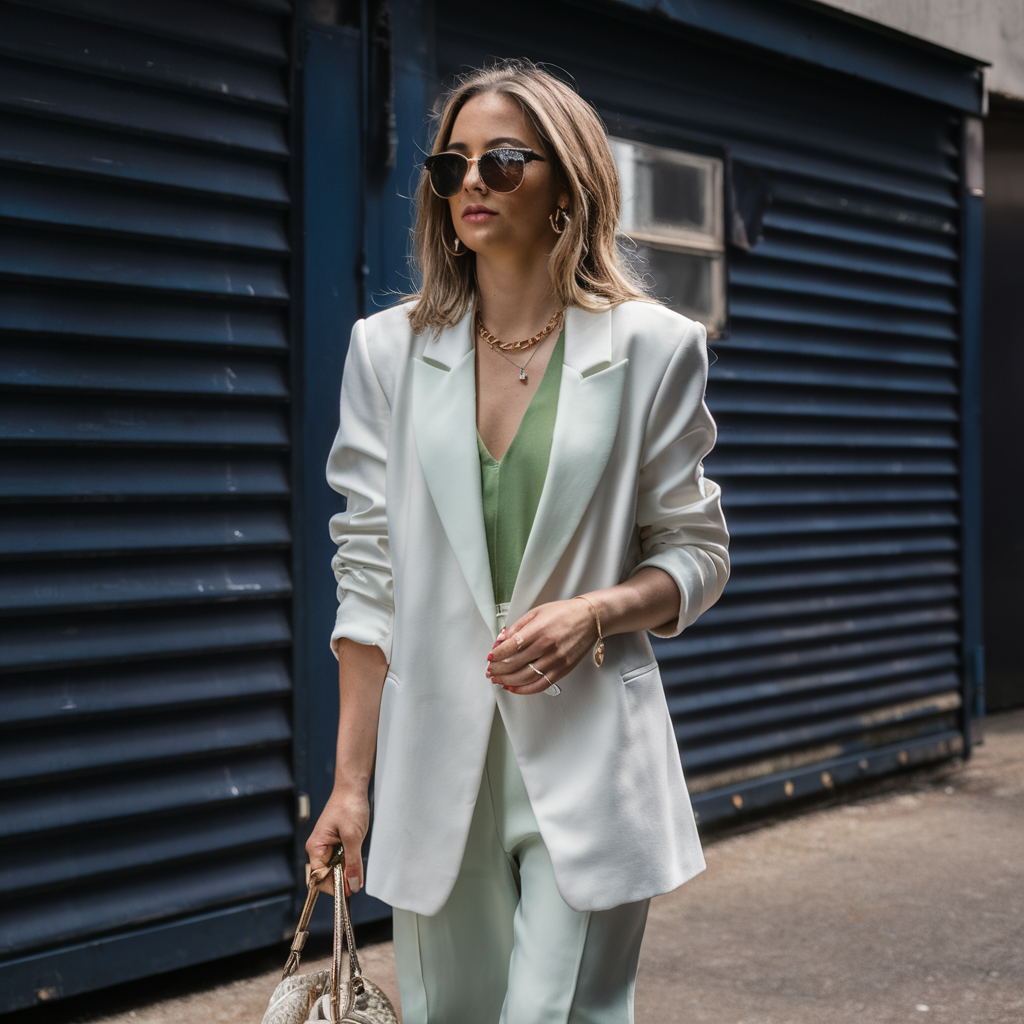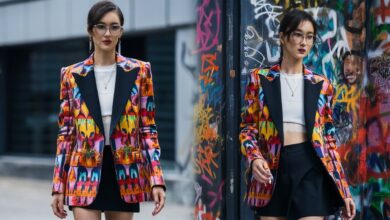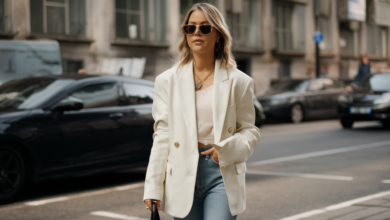In a world where fashion lines between formal and casual are increasingly blurred, the blazertje has emerged as a key piece in many wardrobes. Literally meaning “Blazertje” in Dutch, the blazertje is much more than a shrunken blazer—it’s a fashion statement that offers elegance without rigidity, versatility without sacrificing style. Whether you’re dressing up for a business meeting, going out to dinner, attending casual events, or simply trying to elevate everyday looks, the blazertje can play multiple roles. This article dives deeply into what defines a blazertje, how it compares to traditional blazers, how to choose, style, care for one, and what trends are shaping its current and future popularity in 2025. By the end, you’ll know exactly why this piece is essential, how to integrate it into your wardrobe, and how to make it last.
What Is a Blazertje?
A blazertje is a lighter, often more relaxed version of the traditional blazer. Whereas traditional blazers frequently come with structured shoulder pads, heavier fabric, rigid linings, and a design that leans formal, a blazertje typically uses softer fabrics—linen, cotton blends, lightweight wools or synthetic blends—that allow greater comfort and movement. The cut may be less stiff; hems may be cropped or hit just at or above the hips. Some designs use fewer or lighter linings, softer shoulders, possibly looser fits, or more relaxed silhouettes. The term “blazertje” captures that diminutive nuance: “little blazer,” hinting at something lighter, more flexible, more adaptable. It keeps many of the signature elements of a blazer: lapels, buttons, possibly pockets, sometimes even structured styling cues—but with an ease that makes it wearable in more contexts than only business suits or formal settings.
Blazertje vs Traditional Blazer: Key Differences
To understand when a blazertje works and when perhaps a traditional blazer might still be the better pick, it helps to compare them on a few dimensions:
-
Fabric and Weight: Traditional blazers often use heavier fabrics—thicker wool, full linings, canvas interfacings. Blazertjes lean toward lighter fabrics, less structure, maybe slippery or breathable linings or even unlined backs.
-
Fit and Shape: Blazertjes might have softer shoulders, less rigid tailoring. Traditional blazers often have strong shoulder lines, defined waist shaping, and longer lengths (sometimes below the hip).
-
Formality: Traditional blazers are more formal, suitable for business, uniforms, or formal events. Blazertjes sit in the smart-casual to semi-formal zone: they elevate casual looks and can dress down more formal ones.
-
Versatility: Because of their lighter feel and less formality, blazertjes can be worn pretty often—on casual days, evenings out, hybrid work setups, or even travel—without looking overdressed.
-
Styling Flexibility: Blazertjes pair well with denim, t-shirts, sneakers, dresses, skirts, and can go with formal trousers too. Traditional blazers often demand more formal pairings.
How to Choose a Good Blazertje
Selecting a blazertje that works well for you involves several considerations, so that it complements your wardrobe and body type.
-
Fabric: For warm climates or summer wear, lightweight fabrics like linen, cotton, or lightweight blends are ideal. For cooler weather, wool blends or fabrics with a tighter weave can offer warmth without bulk.
-
Cut & Fit: Look at the shoulders first—these should align well without excessive padding. The length should ideally hit near the hip or just above it. If you are petite, cropped or shorter cuts help; if taller, longer proportions work better.
-
Color & Pattern: Neutral colors (black, navy, beige, grey) give maximum versatility. If you want something more fashion-forward, explore patterns (checks, pinstripes, plaid) or bold colors—but make sure they can still pair with multiple outfits.
-
Details: Buttons (single-breasted vs. double), lapel size, venting (back vents, side vents), pocket type (patch, flap, welt) all contribute to style and comfort. Consider lining—partial linings or breathable ones reduce warmth and weight.
-
Quality & Construction: Even for the casual piece, you’ll want good stitching, durable buttons, clean seams. If you invest a bit more, you often get better structure and longevity.
How to Style a Blazertje: Outfit Ideas
Here are some long, rich-styled ideas (with details) for how to make your blazertje shine in different settings:
-
Smart-Casual Day Out: Pair a neutral blazertje (say, beige or soft grey) with a white or graphic tee and dark-wash jeans. Add low-profile sneakers or loafers. Accessorize lightly—maybe a simple necklace or a watch. Roll up the sleeves slightly to add relaxed feel. The contrast between the polished blazer and casual base pieces gives a clean yet approachable look.
-
Office / Work Setting: Choose a blazertje in darker or neutral tones—navy, charcoal, black—and pair with tailored trousers or a midi pencil skirt. Underneath, wear a crisp shirt or a smart blouse. Shoes can be loafers, oxfords, or modest heels. Keep accessories minimal; maybe a belt and structured handbag. Leave blazer buttoned if formal, open if more relaxed. The goal: projecting professionalism with comfort.
-
Evening Out / Dinner: Use the blazertje as a statement piece: perhaps in velvet, or in a deep jewel color (emerald, burgundy). Pair with a slip dress or a silky camisole and slim trousers. Heels or stylish ankle boots. Add bolder jewelry—earrings or a clutch. Consider tailoring the fit (nip in the waist), so the piece frames the outfit rather than overwhelms.
-
Weekend / Travel / Casual: Use an unstructured (less lining), lighter blazertje layered over a loose button-down or a tee, paired with relaxed jeans or even joggers. Sneakers or slip-ons work. For planes or travel, a soft-lined blazertje offers a smart layer without bulk. Pack one neutral plus maybe one fun color/pattern to mix and match.
Blazertje Trends & Sustainability in 2025
Fashion doesn’t stay still. Right now, some of the strongest trends related to the blazertje are:
-
Sustainable & Eco-Friendly Fabrics: More producers are using organic cotton, recycled fibers, linen, hemp, or more responsible wool. The environmental cost of clothing is in focus, so consumers are choosing pieces that last longer and are made ethically.
-
Gender-Neutral & Inclusive Designs: Many blazertjes are now designed in unisex or inclusive cuts. Oversized fits, relaxed shoulders, flexible sizing. Cuts and stylings that work for different body shapes.
-
Bold Colors, Patterns & Contrast Details: Plaids, checks, pastel colors, color-blocking, and contrast linings are in. Also contrast stitching or buttons as small but visible details.
-
Hybrid and Multi-Purpose Use: Blazertjes that can serve multiple purposes—layering, travel, indoor/outdoor, office/home. Designs that are wrinkle-resistant, that fold well for travel, that allow for layering.
Conclusion
The blazertje is more than just a lite blazer; it’s a style tool that balances comfort, versatility, and elegance in a way few pieces can. As dress codes evolve and people demand more flexibility from their clothes, the blazertje answers by straddling the line between formal and casual, offering a piece you can dress up or down depending on occasion. Choosing the right fabric, fit, color, and construction ensures you get maximum use; styling smartly lets it work in many scenarios. With sustainability and inclusive design shaping fashion trends in 2025, investing in a quality blazertje is not just about looking good—it’s about making a smart, long-lasting choice. Whether you’re heading into a meeting, meeting friends, travelling, or just stepping out casually, having at least one blazertje in your wardrobe can significantly elevate your overall style.
Frequently Asked Questions (FAQ)
Q1: Is a blazertje suitable for formal events?
A1: Yes—depending on the fabric, cut, and color. If the blazertje is made from a more luxurious or refined material (wool, velvet, silk blends), in a darker or neutral shade, and paired with formal trousers or a dress, it can work well for semi-formal or certain formal occasions. But for very formal or traditional events (black-tie, etc.), a full blazer or suit jacket may still be more appropriate.
Q2: Can the blazertje be worn in hot or humid climates?
A2: Absolutely. The lighter the fabric, the better. Linen, light cotton, breathable blends, and partial or unlined designs help. Also choosing lighter colors (beige, light grey, pastels) reflects heat better. Opt for relaxed fits so airflow isn’t restricted.
Q3: How do I know what size or cut of blazertje suits my body shape best?
A3: Start with the shoulder fit—it should align with your natural shoulder without pulling. Then the blazer’s length should balance your torso/leg proportions; if you’re shorter, shorter cuts or cropped styles; taller, a bit longer. The waist shape matters: if you want to emphasize the waist, choose a cut that narrows there; if you want looser, get an oversized style. Try different styles and mirror how the lines of the blazer flow on your body.
Q4: How do I care for a blazertje so it lasts?
A4: Always check care labels. For delicate or luxury fabrics, dry cleaning may be needed. For linen or cotton blends, spot clean stains early, steam to remove wrinkles rather than heavy ironing which damages fibers, hang on good hangers to preserve shoulder shapes, avoid leaving it crumpled in tight spaces. Store in breathable garment bags if possible. Rotate usage so one piece isn’t overused.
Q5: What budget should I expect when buying a good blazertje?
A5: It depends on brand, fabric, and craftsmanship. Affordable fast-fashion options may start low, but often compromise on fabric quality or fit. Mid-range blazertjes with good materials may cost more but deliver on durability and comfort. Premium designer options cost more yet also provide high quality details. It’s often worth investing a bit more for something that fits well and lasts.
Q6: Are there alternatives to a blazertje if I can’t find one or prefer something else?
A6: Yes. Depending on your style needs, items such as tailored jackets, cardigan blazers, structured coats (light weight), or even long vests can sometimes serve similar layering or styling functions. Also trench coats or blazer dresses can mimic some of the elegance a blazertje gives, though in different forms.


